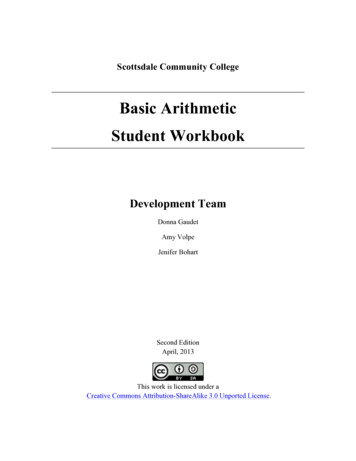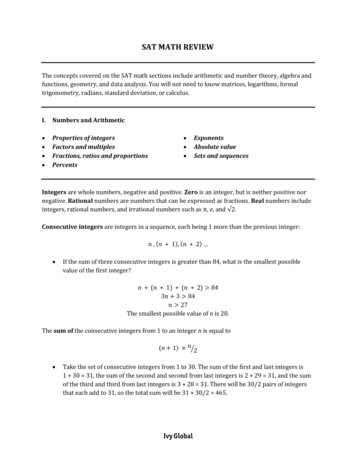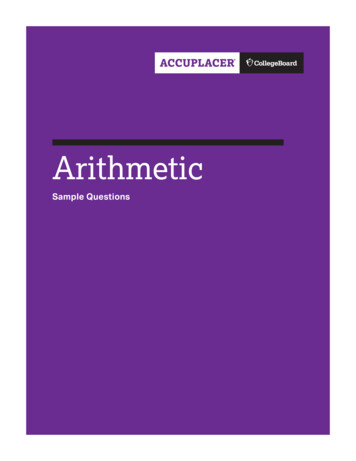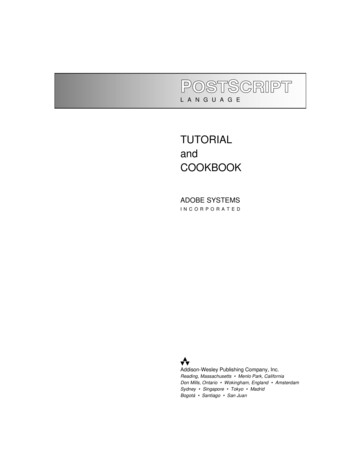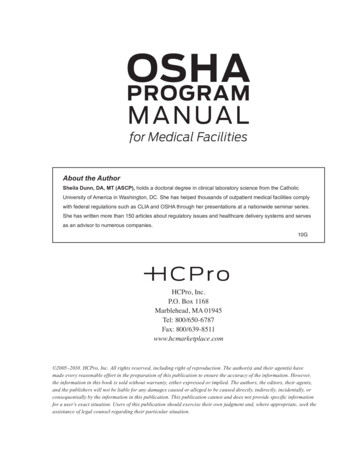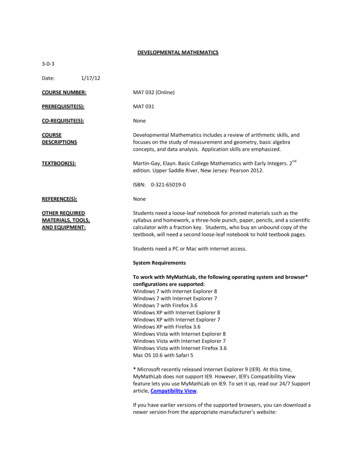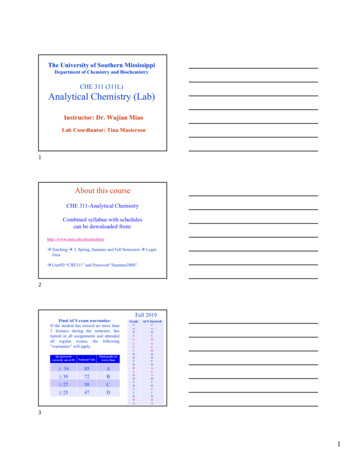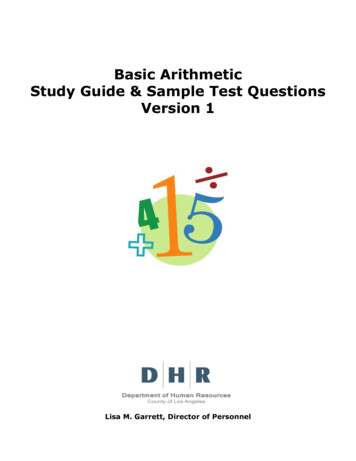
Transcription
Basic ArithmeticStudy Guide & Sample Test QuestionsVersion 1Lisa M. Garrett, Director of Personnel
WELCOMEThank you for your interest in employment with the County of Los Angeles. This guide isdesigned to familiarize and assist you with preparing for examinations containing multiplechoice basic arithmetic items. The sample questions provided in this study guide are intendedto give you an idea of the kinds of basic arithmetic items you may encounter in County tests.However, it is important to note that actual test questions will vary in format, content, and levelof difficulty, depending on the job class being tested.ABOUT THE COUNTY’S EXAMINATIONSAs an Equal Opportunity Employer, the County of Los Angeles takes steps to ensure that ourexam content is job-related. We conduct studies to determine the knowledge, skills, abilitiesand personal characteristics that are essential to satisfactorily perform the duties of the job.These studies assist us in developing the content of our examinations. Testing applicants forjobs provides us with an objective and cost-effective means to assess the qualifications of ourapplicants.HOW SHOULD I PREPARE FOR THE WRITTEN TEST?To prepare for the written test, you should study the concepts assessed in each section. It islikely that there will be several sections to the written test in addition to arithmetic; thus, it isto your benefit to carefully read the job bulletin to determine the knowledge, skill, and abilityareas the written test will cover. In addition, it is important that you read the entire writtentest notice for the location and time of the written test as well as for parking instructions andother important information. Pay special attention to whether testing aids/materials such ashandheld calculators are allowed in the written test. If the test notice indicates that testingaids/materials are allowed, then you are strongly advised to bring these with you, as they willnot be provided. On the test day, it is recommended that you arrive 15 minutes prior to thetest’s starting time, wear comfortable clothes, bring an accurate watch, and make sure you arewell-rested. Also, remember to bring your test notice and a picture I.D. such as a driverlicense, or you may not be admitted into the test!NOTE: Applicants who require special testing arrangements such as readers or interpretersmust provide seven (7) days advance notice of their disability and requested accommodation.Check the front side of the job bulletin for telephone numbers to call and make disabilityaccommodation requests. The County will attempt to meet reasonable accommodationrequests whenever possible.TEST-TAKING TIPSMost County examinations have a set time limit, so it is important that you work quickly, butnot so fast as to become careless. Always read all the possible choices before selecting youranswer. If you do not know the answer to a problem, it is usually best to skip it and move onto the others. Note that on most County examinations, your score is based on the number ofcorrect responses. If you are not sure of the answer to a problem, eliminate the answers youbelieve are wrong, and mark the choice that is your best response. Above all, budget yourtime, pace yourself, and avoid getting bogged down on any single question.2
SAMPLE BASIC ARITHMETIC QUESTIONSBasic arithmetic items test your knowledge of, and ability to interpret and solve problems of amathematical nature, using such operations as addition, subtraction, division, and multiplication, and ina variety of problem formats and situations. However, actual problems will vary from one test toanother. For example, a test problem may require you to calculate the totals in a supply budget, muchlike you may be asked to do in the position for which you are testing. The following are examples of thetypes of basic arithmetic problems most common to County examinations. Answers and explanations forthe problems begin on page 8 of this study guide. A glossary of mathematical terms has also beenincluded on page 7 for your reference.1. A.B.C.D.2. A.B.C.D.3.4.4 feet, 5¼30 feet, 610 feet, 23¾44454647inchesinchesinchesinchesfeet, 11 inchesfeet, 5 inchesfeet, 2 inchesfeet, 1 inch24613232,47234,27235,24236,422 650.550321750.602329/10 – 3/20A.B.C.D.3/44/54/155/153
5.6. 9 days, 18 hours,5 days, 16 hours,2 days, 15 hours,10 1718181916172757minutesminutesminutesminutes 2,782.50 2,785.00 2,900.00 3,001.5071%72%73%75%If two-thirds of Sam’s weekly income is 480, what is one-fourth of his weekly income?A.B.C.D.10.681113If 43 of the 148 reams of paper purchased by a department are used, what is the percentagethat remains? Round your answer to the nearest whole ��s salary is 2,650.00 per month. If she receives a salary increase of 5%, what is hernew monthly salary?A.B.C.D.8.3012152065 is what percent of 500?A.B.C.D.7.days,days,days,days, 165 180 240 280A 9' x 15' tool room was enlarged to 11' x 20'. How many square feet of floor space feetfeetfeetfeet4
11.In July, 305 employees worked on an assembly line. In August, 30 employees resigned and11 were hired. In September, 9 employees resigned and 23 were hired. In October, 17employees were hired. What was the total number of employees as of November 1st?A.B.C.D.12.In a Social Services Agency, each of the 18 employees is responsible for maintaining acaseload of 360 cases. When 3 employees leave the department, their caseload isredistributed equally among the remaining employees. How many cases are each of theremaining employees now responsible for maintaining?A.B.C.D.13. 2,108.00 2,343.80 2,628.20 3,189.40Ernesto takes out a loan from his retirement fund. If he is repaying the loan in installmentsof 72.12 every two weeks, how much of the loan will be paid back in 32 weeks?A.B.C.D.15.405432468472Fred’s gross salary is 850 per week. From his salary, 11% is removed for federaldeductions; 5.5% for state deductions; and 6.2% for the company’s pension plan. If each ofthese deductions is taken as a percent of Fred’s gross salary, what is his net salary for a fourweek period?A.B.C.D.14.302309317325 1,081.80 1,153.92 1,276.48 1,730.88Martha can file 50 letters in 10 minutes. David can file 40 letters in the same amount oftime. How many letters will the two of them file in 9 hours?A.B.C.D.4,8604,8704,9504,9805
16.Four machines, each costing 5,700, were purchased for an office. Each machine requiresthe service of an operator at a salary of 1,100 per month. These machines are to replace 8clerks, two of whom each earn 750 per month, three of whom each earn 650 per month,and three of whom each earn 950 per month. How many months will it take to recover thecost of the machines?A.B.C.D.17.An Information Services Manager is purchasing a large number of word processing softwarelicenses at a cost of 125 each. The software company gives a volume discount of 3.5% forlarge purchases. If the department manager has a budget of 17,300 to purchase thelicenses, approximately how many licenses can she purchase?A.B.C.D.18. 475.50 495.00 525.75 550.00If Kim reduces the weekly number of hours she works by one-fourth and her current weeklyincome is 520.00, what is her new weekly income?A.B.C.D.20.122138143146An employee who earned 550 a week working 35 hours had her pay increased by 5 percent.Later, her hours were reduced to 30 per week, but the new hourly rate of pay was retained.What was her new amount of weekly pay?A.B.C.D.19.10 months11 months12 monthsMore than 12 months 285.00 335.00 360.00 390.00Pamela’s salary is 3125.00 per month. If she receives a salary increase of 5%, her newmonthly salary isA.B.C.D. 3158.90. 3197.50. 3215.65. 3281.25.6
GLOSSARY OF MATHEMATICAL TERMSArea:The number of square units that covers a shape or figure.Denominator:The bottom part of a fraction. (Example: in the fraction ¾, 4 is thedenominator.)Digit:The ten numerals 0, 1, 2, 3, 4, 5, 6, 7, 8, and 9. The number 14has two digits: 1 and 4.Difference:The result of subtracting one number from another.Divisor:In a division problem, the number that is divided into another (Forexample when dividing 4 into 20, the 4 would be the divisor, as it isused to divide the number 20 into five parts).Factor:One of two or more numerical values that are multiplied together toyield a product.Fraction:A number expressed in terms of a numerator and denominator.Least CommonMultiple:The smallest, non-zero multiple of the denominators of two or morefractions.Numerator:The top part of a fraction. (Example, in the fraction ¾ 3 is thenumerator).Operation:Any one of the basic arithmetic functions of addition, subtraction,multiplication, or division.Product:The result of two numbers being multiplied together.Quotient:The result of dividing one number into another.Sum:The result of adding together two or more numbers.7
ANSWERS AND EXPLANATIONS TO ARITHMETIC SAMPLE QUESTIONSNOTE: Typically, there are multiple ways of obtaining the correct answer to each question, only one ofwhich is provided as the answer explanation. Use the glossary on page 7 to help you define any termswith which you may be unfamiliar.1.Correct Answer: B Add the measurements in the inches column, for a total of 17 inches (Step #1). Since 12 inches equals 1 foot, convert the 17 inches to 1 foot, 5 inches; carry the 1 footinto the feet measurement column; and sum (Step #2).STEP #14 feet, 5¼30 feet, 610 feet, 2 3¾172.STEP #21 footinchesinchesinchesinchesinches4 feet, 5¼30 feet, 610 feet, 2 3¾45 feet, 5inchesinchesinchesinchesinchesCorrect Answer: A Working from right to left, multiply 246 by each of the three digits in the factor “132”separately. You may wish to add zero placeholders (shown in bold) to help ensure thatcolumns are aligned correctly (Step #1). Add the products from Step #1 to arrive at the correct answer (Step #2).STEP #1xSTEP #2246132492738024600x 824613249273802460032472
3.4.Correct Answer: C Set up the problem by adding zero placeholders (shown in bold) as necessary to ensurethat columns and decimal points are aligned appropriately (Step #1). Working right to left, add each column, making sure to carry values over to the nextcolumn to the left as appropriate (Step #2).STEP #1STEP #2004 5 .0 0 0 0 00000.9 000004 3 6 .0 0 5 001 1 6 8 .00000 0000.6 4 5 3 2004 5 .0 0 0 0 00000.9 000004 3 6 .0 0 5 001 1 6 8 .00000 0000.6 4 5 3 21 6 5 0 .5 5 0 3 21111Correct Answer: A To solve, find the least common multiple (LCM) for the denominator of each fraction. TheLCM is the smallest non-zero number that is a multiple of both denominators. In thisproblem, the LCM is 20. Since 3/20 already has a denominator of 20, only 9/10 needs to be converted so that ithas a denominator of 20. Multiplying the denominator (10) by 2 converts it to 20;therefore, to convert the fraction 9/10, multiply both the numerator (9) and thedenominator (10) by 2, so that the fraction becomes 18/20 (Step #1). Subtract 3/20 from 18/20 (by subtracting the numerators), for a difference of 15/20(Step #2). Simplify 15/20 by dividing the numerator and denominator each by 5, to equal 3/4(Step #3).STEP #19x210x2 STEP #21820183 20209 STEP #3152015 520 5 34
5.Correct Answer: B Add the measurements in the minutes column for a total of 77 minutes (Step #1). Since 60 minutes equals 1 hour, convert the 77 minutes from Step #1 into 1 hour, 17minutes; carry the 1 hour into the hours measurement column; and sum for a total of 60hours, 17 minutes (Step #2). Since 24 hours equals 1 day, convert the 60 hours from Step #2 into 2 days, 12 hours;carry the 2 days into the days measurement column; and sum for a total of 18 days(Step #3).STEP #1 6.9 days,5 days,2 days,18161510hours,hours,hours,hours,STEP #23716131177minutesminutesminutesminutesminutes 1 hour9 days,5 days,2 days,1816151060hours,hours,hours,hours,hours,STEP #33716131117minutesminutesminutesminutesminutes2 days9 days,5 days,2 days,18 days,1 1117minutesminutesminutesminutesminutesCorrect Answer: D Divide 65 by 500. Set up the problem by adding a decimal and zero placeholders (shownin bold) to make 65 into 65.00. Next, determine the decimal place for the answer bycounting the number of zero placeholders you added to 65 to make it divisible by 500.Since two zeros were added to 65, count backwards from right to left two decimal placesto convert the answer to .13 (Step #1). Multiply .13 by 100 to convert it to a percent. Add a decimal point and two zeroplaceholders (shown in bold) to make 100 into 100.00 to match the number of decimalplaces in the number it is being multiplied with (.13) and vertically align the decimalpoints in the two numbers. Count the number of decimal places to the right of thedecimal point in 100.00 and .13 (which equals four) to determine that the answer shouldalso have four decimal places. Count backwards from right to left four places and insert adecimal point, which results in 13.0000, or 13 (Step #2).STEP #1STEP #2.13500 6 5.00- 5 0.01 5.001 5.000100 . 00. 13300 0 0 10 00 013 00 0 0x13.000010
7.Correct Answer: A Multiply 2,650.00 by the decimal equivalent of 5% (.05) to determine that 132.50 isthe amount of the salary increase (Step #1). Add 132.50 to Juanita’s previous monthly salary ( 2,650) to determine that 2,782.50 isher new monthly salary (Step #2).STEP #1x8.STEP #2 2650.00.05 132.50 2 6 5 0 .0 0 1 3 2 .5 0 2 7 8 2 .5 0Correct Answer: A Determine the number of reams of papers that remain by subtracting 43 from 148, toequal 105 (Step #1). Determine what percentage of 148 equals 105 by dividing 105 by 148 for an answer of.7094, which is rounded to 71% (Step #2).STEP #1-9.STEP #214843105105 148.7094 71%Correct Answer: B Since 480 is two-thirds of Sam’s weekly income, divide 480 by 2 to determine that 240is one-third of his weekly income (Step #1). Multiply 240 by 3 to determine that 720 is his weekly income (Step #2). Divide 720 by 4 to determine that 180 is one-fourth of his weekly income (Step #3).STEP #12402 480-408-800STEP #2x240372011STEP #31 804 7 20-432-3 200
10.Correct Answer: D Find the total area of both the original tool room and the enlarged tool room (Step #1).The formula for area is A L x W, where A area; L length; and W width. Theproduct is expressed in square feet. Subtract the area of the original tool room from the area of the enlarged tool room todetermine the amount of floor space that was added (Step #2).STEP #1Original tool room: 9' 15' 135 square feetEnlarged tool room: 11' 20' 220 square feetSTEP #2220 135 85 square feet11.Correct Answer: C Subtract the total number of employees who resigned since July from the number ofemployees on the assembly line in July (Step #1). Add the total number of hires since July to the answer from Step #1 to determine thenumber of employees on the assembly line as of November 1st (Step #2).305 (number of employees in July)STEP #1-39 (total number resigned from August through October)266STEP #2 51 (total number hired from August through October)31712.Correct Answer: B Multiply the total number of cases per employee (360) by the total number of employees(18) to determine the total number of cases (Step #1). Divide the total number of cases (6480) by the remaining employees (15) to determinethe number of cases per employee (Step #2).STEP #1STEP #24 3215 6480-6048- 4530- 300360x182880 360648012
13.Correct Answer: C Multiply Fred’s gross salary by the decimal equivalent of each percent deduction to get thedollar amount for each deduction; sum the three deductions (Step #1). Subtract the sum of the deductions from Fred’s weekly gross salary to get his net salary(Step #2). Multiply Fred’s weekly net salary by 4 to get his net pay for the four-week period(Step #3).STEP #1 850.00 x 0.11 850.00 x 0.055 850.00 x 0.06214. STEP #2 93.50 46.75 52.70 192.95 850.00- 192.95 657.05x 657.054 2628.20Correct Answer: B Divide 32 by 2 to determine the total number of payments made during the 32-weekperiod (Step #1). Multiply the number of payments (16) by the payment amount ( 72.12) to determine thetotal amount paid back at the end of the 32-week period (Step #2).STEP #1215.STEP #3STEP #21632- 212- 12072.121643272 72121153.92xCorrect Answer: A Divide 50 by 10 to determine the number of letters that Martha can file in one minute. Dothe same for David by dividing 40 by 10; sum these amounts to determine the totalnumber of letters these workers can file in one minute (Step #1). Multiply the total number of letters per minute (9) by the total number of minutes in onehour (60) to determine the total number of letters that Martha and David can file in onehour (Step #2). Multiply the total number of letters per hour that Martha and David can file by the numberof hours these workers will spend filing letters (Step #3).STEP #1Martha:David:50 10 5 letters per minute40 10 4 letters per minute9 letters per minute13STEP #2STEP #3609540540x94860x
16.Correct Answer: C Multiply the cost of each machine ( 5,700) by 4 to determine that the total purchase costis 22,800. Multiply the monthly salaries for each of the four operators ( 1,100) by 4 to determinethat the total monthly labor cost to operate the four machines is 4,400. Multiply the number of clerks by their respective monthly salary rate to determine that 6,300 is the total monthly labor cost for the eight clerks as follows:(2 750) (3 650) (3 950) 6,300. Subtract the total salaries for the operators ( 4,400) from the total clerk salaries ( 6,300)to determine that the amount of monthly labor cost savings is 1,900. Divide the total cost of the machines ( 22,800) by the total monthly savings ( 1,900) todetermine that it will take 12 months to recover the cost of the machines.17.Correct Answer: C Multiply the pre-discount cost per license ( 125) by the decimal equivalent of the percentdiscount (.035) to determine that 4.38 (rounded) is the total savings per license. Subtract the total discount per license ( 4.38) from the pre-discount cost per license( 125) to determine that 120.62 is the discounted cost per license. Divide the total budgeted amount for licenses ( 17,300) by the discounted cost perlicense ( 120.62) to determine that 143 licenses can be purchased within the currentbudget.18.Correct Answer: B Multiply the original weekly wage ( 550) by the decimal equivalent of 5 percent (.05) todetermine that 27.50 is the amount of the increase. Add the amount of the increase ( 27.50) to the original weekly wage ( 550) to determinethat 577.50 is the new weekly wage. Divide the new weekly wage ( 577.50) by 35 to determine that 16.50 is the new hourlyrate. Multiply the new hourly rate ( 16.50) by 30 to determine that 495.00 is the new amountof weekly pay.14
19.Correct Answer: D Convert the fraction one-fourth (¼) to a decimal by dividing the numerator in the fraction(1) by the denominator (4). Set up the problem by adding a decimal point and zeroplaceholders (shown in bold), to make 1 into 1.00. Next, determine the decimal place forthe answer by counting the number of zeros you added to 1 to make it divisible by 4.Since two zeros were added to 1, count backwards from right to left two decimal places toconvert the answer to .25 (Step #1). Multiply .25 by 520 to determine that 130.00 is one-fourth of Kim's weekly income.You may wish to add zero placeholders (shown in bold) to ensure that columns arealigned correctly (Step #2). Subtract 130.00 from 520.00 to get 390.00, which is Kim’s new weekly income(Step #3).STEP #1.2 54 1.00-0.8.2 0- .2 00STEP #2STEP #352 0. 252 60 0 1 0 40 01 3 00 0 520.00- 130.00 390.00x 130.0020.Correct Answer: D Convert 5% to a decimal by dividing 5 by 100. Set up the problem by adding a decimalpoint and zero placeholders (shown in bold), to make 5 into 5.00. Next, determine thedecimal place for the answer by counting the number of zeros you added to 5 to make itdivisible by 100. Since two zeros were added to 5, count backwards from right to left twodecimal places and place a 0 before the 5 to convert the answer to .05 (Step #1). Multiply 3125.00 by .05 to determine the amount of Pamela’s pay raise, to yield ananswer of 156.25 (Step #2). Making sure to carry values over across columns as necessary, add 156.25 to Pamela’sprevious salary for the sum of 3281.25, her new monthly salary (Step #3).STEP #1STEP #2STEP #3.0 5100 5.00-5.0 00 3125.00x.05 156.2500 3125.00 156.25 3281.25115
types of basic arithmetic problems most common to County examinations. Answers and explanations for the problems begin on page 8 of this study guide. A glossary of mathematical terms has also been included on page 7 for your reference. 1. 4 feet, 5¼ inches 30 feet, 6 i


